Preface
Since more than a year ago ChatGPT Since generative AI was thrust into public consciousness, we’ve been exposed to thousands of new consumer products infused with the magic of AI — from video generators to workflow hacks, from creative tools to virtual companions.
Six months ago, we took a deep dive into network traffic data and found thatVisits, duration, and growthSpeed toRevenueFor the most popular generative AI ProductsThe rankings were compiled and reveal how consumers actually use the technology.
Now, six months later, we’ve updated our analysis again and ranked the top 50 AI for the Web products according to data from SimilarWeb (as of February 2024). Our findings are surprising: compared to our initial report in September 2023, more than 40% companies on the list are new.

However, unlike our original analysis—in which we ranked companies based on web traffic first and then added mobile app data for those companies—this time we ranked both web and mobile app traffic byArtificial Intelligence ProductsDivided into two separate lists.
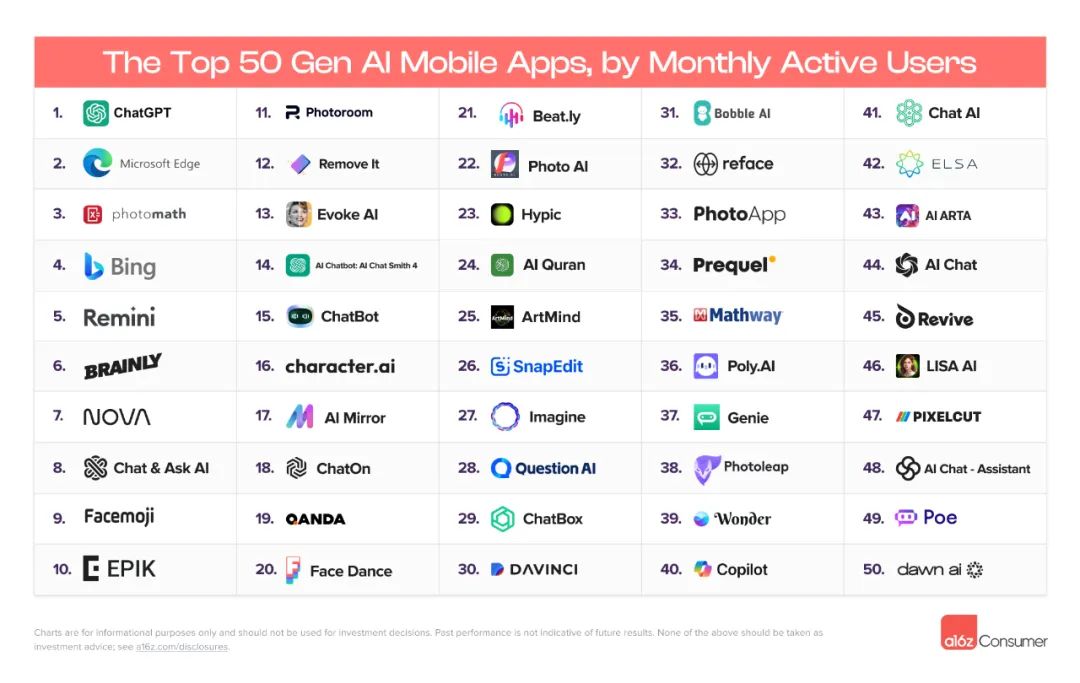
Beyond these rankings, however, the data also sheds light on the buzz surrounding new and expanding categories, artificial intelligence,investandParticipation ModeHere are some of our key takeaways:
Given ChatGPT’s impressive early growth — it was already the 24th most visited website in the world in our analysis six months ago — we expect this groundbreaking chatbot to maintain its position at the top of the list. In fact, ChatGPT has nearly 2 billion web visits per month, roughly the same as the second-most visited company on the list. Bard(now Gemini) five times.
With Gemini, fellow creators Character.AI and writing assistant Quillbot However, that’s not to say the list has remained static over the past six months:22 companies are new entrants to the web traffic rankings.
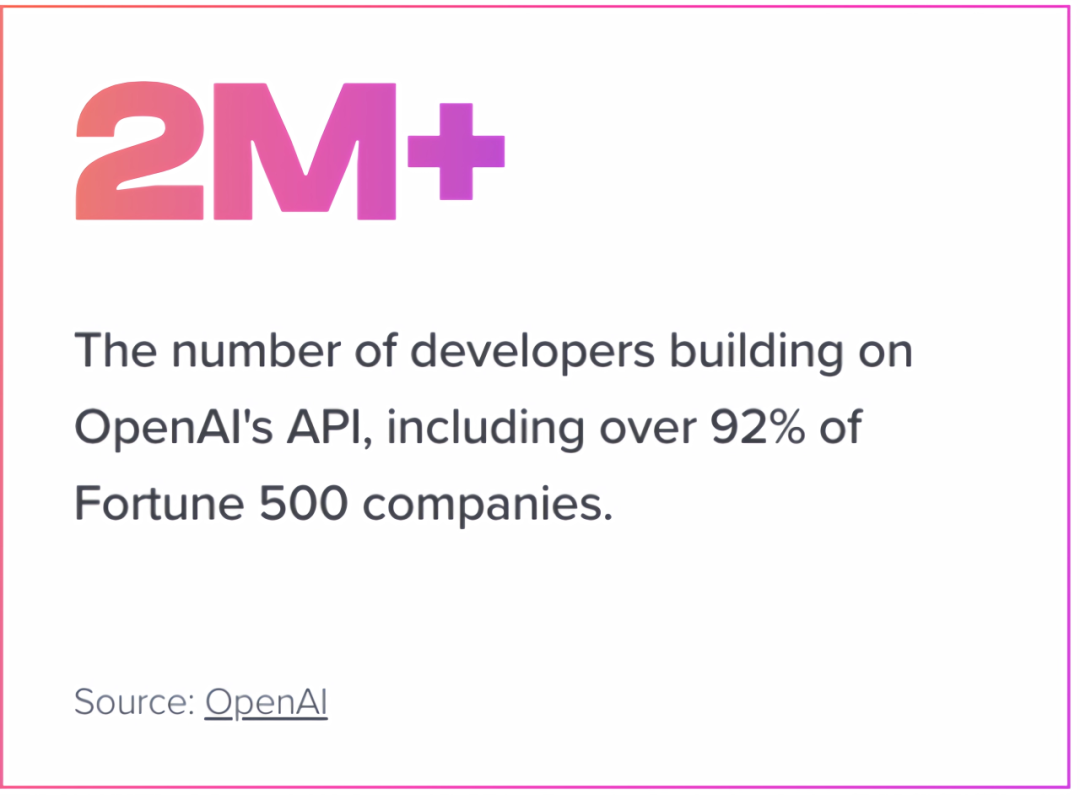
Among the so-called new members, the highest ranking includes AI research assistant Liner; Anthropic’s AI assistant Claude; and threeUncensoredAI companion apps: JanitorAI, Spicychat, and CrushOn (more reasons behind the surge in AI applications, detailed below).
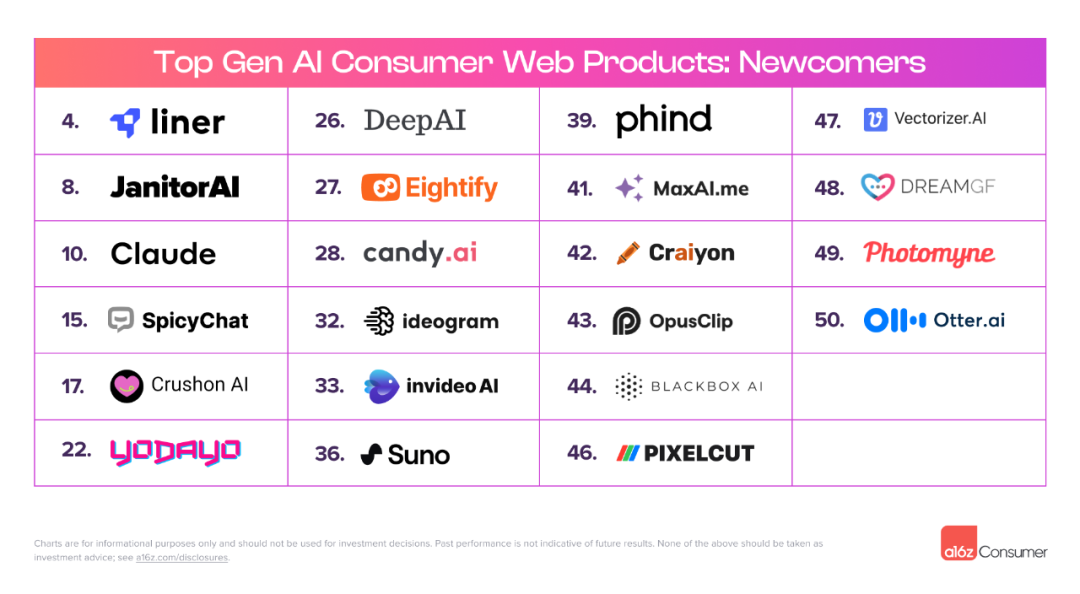
The mobile chart above is brand new. ChatGPT is also ahead here — but by a much smaller margin. In terms of monthly active users, ChatGPT is roughly the size of the second and third largest apps. Microsoft Edge and Photomath For mobile products, the top five areNew Bing(now AI Copilot) andPhotomathand AI Image EnhancerRemini.
Interestingly, there are five AI companies that are trulyCross-border", with both web products and mobile apps making the top 50: ChatGPT, Character.AI, chatbot aggregator Poe, and image editors Photoroom and Pixelcut.
Six months ago, we noted that LLM-based general-purpose assistants like ChatGPT made up the majority of web traffic. In our updated analysis, we saw two new categories enter the mix:Music and Productivity(including tasks such as research, coding assistance, and document summarization).
Sunois the only music company to make the list so far. The tool generates original songs from text prompts in a browser — including lyrics in a variety of styles. Suno started out as a Discord-only product, similar to Midjourney, but launched a standalone website and Copilot extension in December 2023.

Several major consumer AI products today, such as Suno, started on Discord servers or still run primarily through Discord. The Discord platform provides a server (and community!) without the need for a full front-end product build. The true traffic of a Discord server is almost impossible to measure, but the network traffic to each server invite page is a proxy. On this metric, as of January 2024, there are 9 AI products or communities ranked in the top 100 by invite traffic, including Midjourney tops the list.
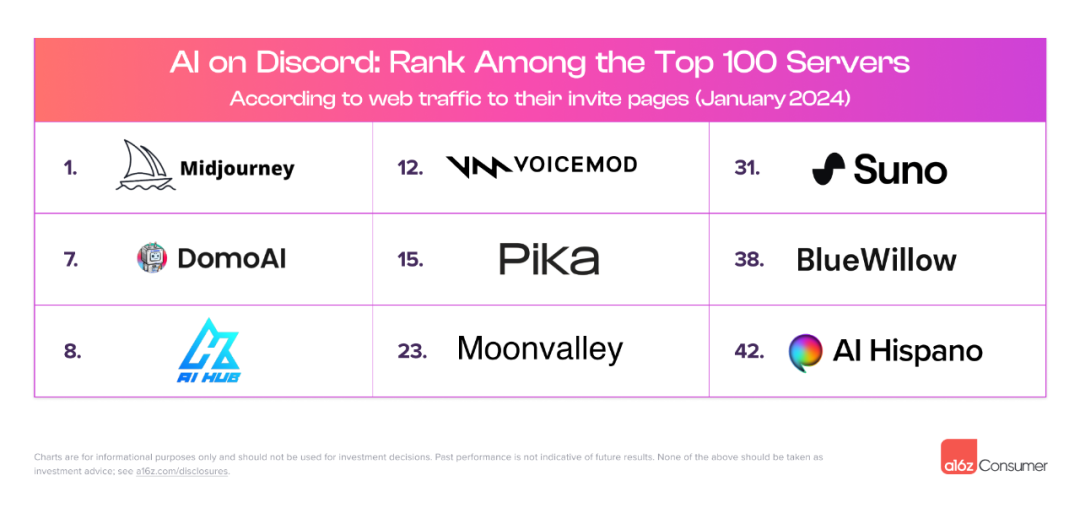
The second notable new category on the list is Productivity. AI-native platforms can elevate the level of interaction people have with software, enabling them to delegate routine tasks and reduce the time spent on administrative overhead. The Productivity category includes seven companies in the ranking:Liner,Eightify,Phind, MaxAI,Blackbox AI,Otter.ai and ChatPDF.

Through features like in-stream editing and summarization, these companies are focused on helping employees, freelancers, and SMB owners get their work done more efficiently. For example,Eightify supply Youtube Video summary, while Otter.ai Real-timeRecording meeting minutes and transcriptions.
Among the seven productivity apps on the list areSix fully passed We expect more AI productivity tools to work alongside the work users are already doing.flow"Run without copying and pasting prompts and output between work and assistants like ChatGPT.

In the future, AI productivity companies may invent new end-to-end workflows built around the unique capabilities of AI. AI workflow products can help users identify areas where improvements can be made and then automatically make those improvements.
Having an AI companion may seem niche, but the activity has become a staple of generative AI. Millions of people already—Including myself— Already in a relationship with a chatbot. Web and mobile data foreshadow a coming societal shift: AI companionship is going mainstream.
Six months ago, only two AI companion companies made the list of 50; in this updated analysis, eight are in web apps and two are in mobile.
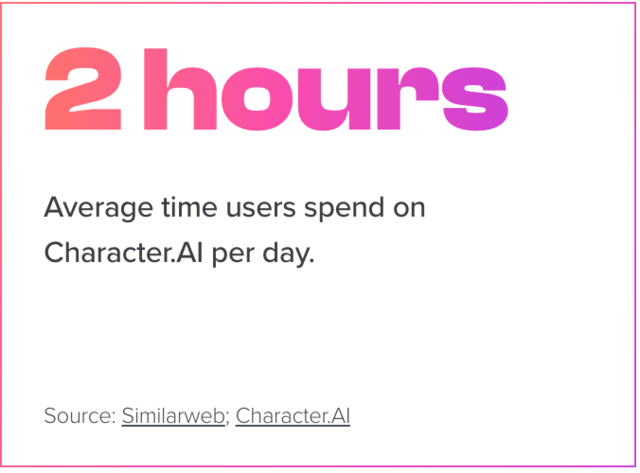
Six of the eight network products claim to beUncensored”, which means users can have conversations or interactions with them that might be restricted on platforms like ChatGPT.
Users primarily access these products via the mobile web, rather than desktop, even though almost none of them offer apps. On average, 751% of the traffic to the uncensored companion tools on the web list came from mobile devices.
For companion products with mobile apps, engagement is exceptionally high. The most successful products in this category become a core part of their users’ daily lives, becoming as commonplace as texting a friend (if not more common!).

According to SensorTower, Character.AI attracts an average of 298 sessions per user per month, while Poly.AI averages 74 sessions per user.
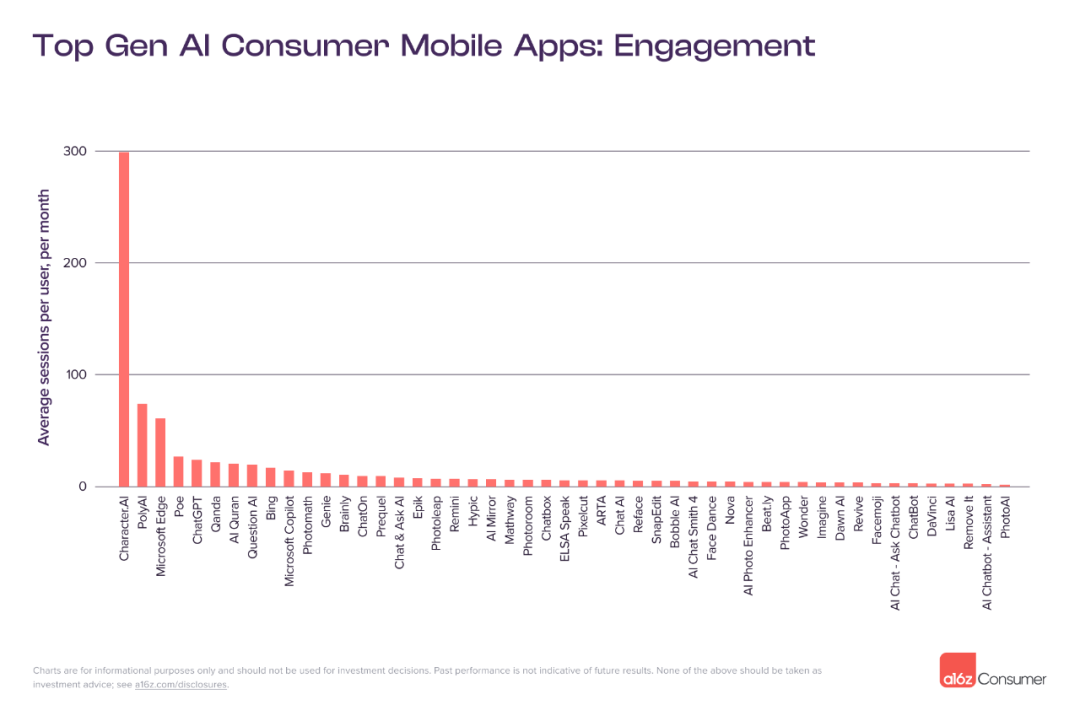
We’re starting to see early signs of a wider range of companion applications beyond AI “boyfriends” and “girlfriends,” including friendship, mentoring, entertainment, and, eventually, health care. In fact, early studies suggest that AI outperforms real doctors in diagnostic accuracy. Many companion products are multifaceted: In a recent study in Nature, the Replika chatbot reduced suicidal ideation among 3% users.
04.The reasons behind the mobile vs web split
first, the categories of AI usage for mobile apps and web apps are very different. Typically, web products support more complex, multi-step workflow products around content generation and editing.
at present!This includes AI Voice Toolkit ElevenLabs, AI Art Generator Leonardo and AI Demo Builder Gamma and other products, all of which rank in the top 20 of the web-based AI generation products.

Secondly, mobile app usage skews toward general assistants, with many of these offerings mimicking ChatGPT. While perusing the list of top mobile apps, you might notice that there are 10 companies with names that are very… similar to ChatGPT. This is partly because ChatGPT was relatively slow to launch its own app, which created an opportunity for imitators to quickly gain an App Store optimization advantage, especiallyIn the case where they pay for advertising.
Among them, some mobile applications that imitate ChatGPT are called "Wool Software”. They trick users into believing they are providing access to ChatGPT premium models with similar titles, but in reality, charge for access to the same models that ChatGPT offers for free.in addition, these apps often change their names or descriptions, making it difficult for app stores to "police" this behavior.
Other popular AI mobile app categories are tailored to the unique capabilities of mobile phones. There are seven dedicated avatar generation products in the app list; the many selfies saved on most people's phones can serve as ready-made training data. In addition, three top apps -Facemoji (No. 2),Bobble (No. 31) and Genie (No. 37) – is a mobile-specific keyboard that allows users to send texts with the help of AI.

also,Education Technologyis another popular category on mobile devices, where users can scan homework problems with their phones (Photomath) or learn a language through real-time conversation (Elsa). Notably, while most of the top AI mobile apps are bootstrapped, meaning they have not raised outside funding, seven of the top AI mobile apps, according to PitchBook data, are Edtech Four of the applications raised more than $30 million.
05.The pursuit of globalization
Cerebral Valley San Francisco may be the epicenter of AI, but wildly popular products are being developed all over the world. This is especially true for mobile apps. While more than 30% of the top AI web products on the list come from the Bay Area, only 12% of mobile app developers are based in the San Francisco Bay Area. Likewise, while more than half of the top AI web products were developed in the United States, less than a third of mobile apps originated stateside.
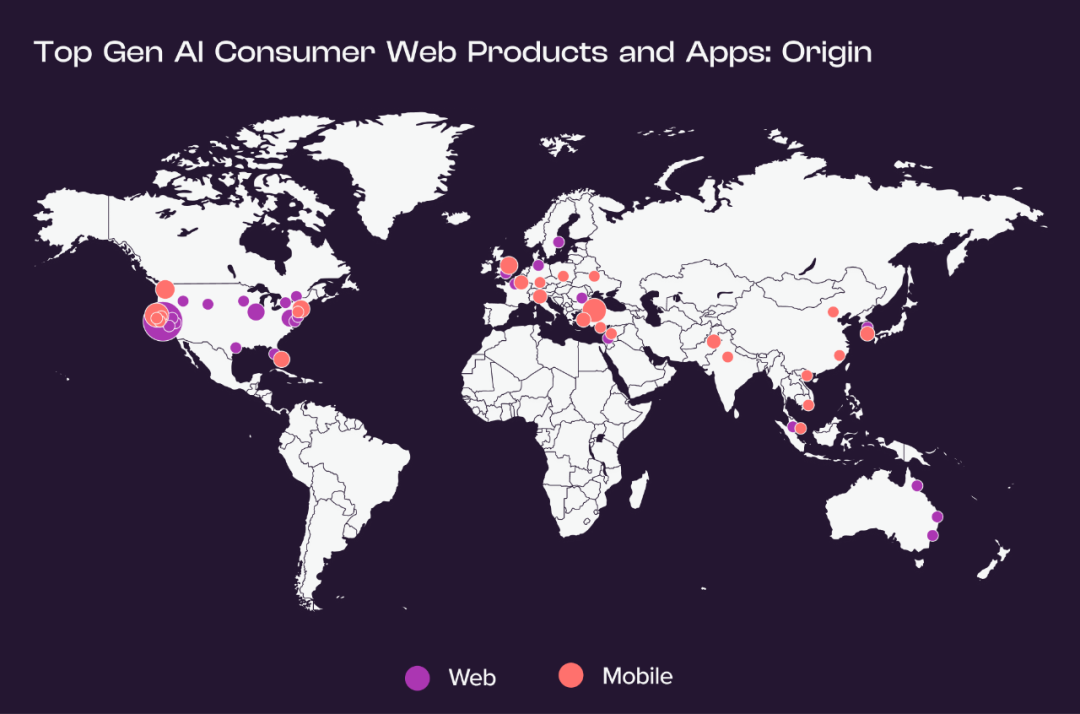
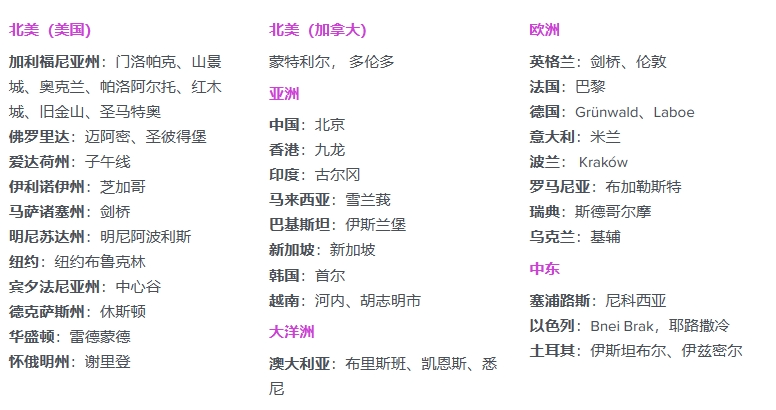
Some mobile developers have already had multiple successes: Istanbul-based app studio Codeway, for example, created an AI photo animatorFace Dance, Chatbot Application Chat&Ask AI and AI Art GeneratorWonder, all of which are on the list of top AI mobile apps. HubX, also based in Turkey, has developed Nova Chatbots,DaVinci Art Generator and PhotoApp Enhancer.
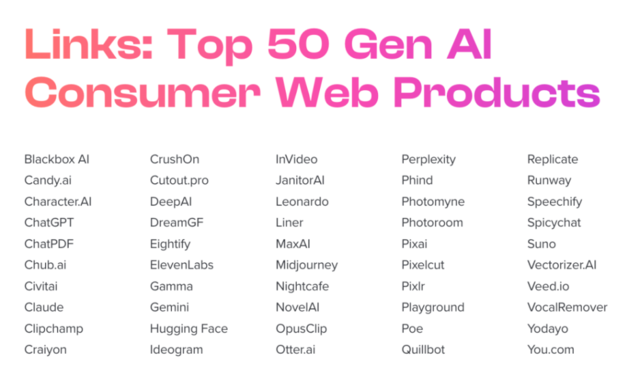
These application studios often benefit from cross-productHow to start the application,Attract trafficand profit from itSharing expertise. Rather than raising money, some of them are focused on generating revenue as efficiently as possible.Others are indeed taking the venture capital route—Bending Spoons, the Milan-based tech company behind video editor Splice and photo enhancer Remini (No. 5 on the mobile apps list),Recently announced $155 million in equity financing.
* * *
It’s clear that a new generation of AI-native products and companies are developing faster than ever before, with increasing user engagement. We believe AI will power many more emerging companies over the next decade.